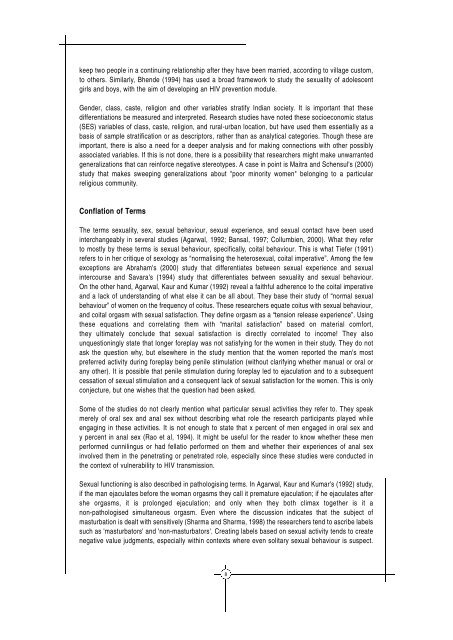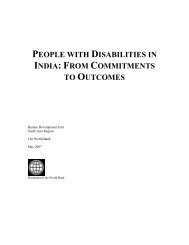FREE Download - TARSHI
FREE Download - TARSHI
FREE Download - TARSHI
You also want an ePaper? Increase the reach of your titles
YUMPU automatically turns print PDFs into web optimized ePapers that Google loves.
keep two people in a continuing relationship after they have been married, according to village custom,<br />
to others. Similarly, Bhende (1994) has used a broad framework to study the sexuality of adolescent<br />
girls and boys, with the aim of developing an HIV prevention module.<br />
Gender, class, caste, religion and other variables stratify Indian society. It is important that these<br />
differentiations be measured and interpreted. Research studies have noted these socioeconomic status<br />
(SES) variables of class, caste, religion, and rural-urban location, but have used them essentially as a<br />
basis of sample stratification or as descriptors, rather than as analytical categories. Though these are<br />
important, there is also a need for a deeper analysis and for making connections with other possibly<br />
associated variables. If this is not done, there is a possibility that researchers might make unwarranted<br />
generalizations that can reinforce negative stereotypes. A case in point is Maitra and Schensul's (2000)<br />
study that makes sweeping generalizations about "poor minority women" belonging to a particular<br />
religious community.<br />
Conflation of Terms<br />
The terms sexuality, sex, sexual behaviour, sexual experience, and sexual contact have been used<br />
interchangeably in several studies (Agarwal, 1992; Bansal, 1997; Collumbien, 2000). What they refer<br />
to mostly by these terms is sexual behaviour, specifically, coital behaviour. This is what Tiefer (1991)<br />
refers to in her critique of sexology as “normalising the heterosexual, coital imperative”. Among the few<br />
exceptions are Abraham's (2000) study that differentiates between sexual experience and sexual<br />
intercourse and Savara's (1994) study that differentiates between sexuality and sexual behaviour.<br />
On the other hand, Agarwal, Kaur and Kumar (1992) reveal a faithful adherence to the coital imperative<br />
and a lack of understanding of what else it can be all about. They base their study of “normal sexual<br />
behaviour” of women on the frequency of coitus. These researchers equate coitus with sexual behaviour,<br />
and coital orgasm with sexual satisfaction. They define orgasm as a “tension release experience”. Using<br />
these equations and correlating them with “marital satisfaction” based on material comfort,<br />
they ultimately conclude that sexual satisfaction is directly correlated to income! They also<br />
unquestioningly state that longer foreplay was not satisfying for the women in their study. They do not<br />
ask the question why, but elsewhere in the study mention that the women reported the man's most<br />
preferred activity during foreplay being penile stimulation (without clarifying whether manual or oral or<br />
any other). It is possible that penile stimulation during foreplay led to ejaculation and to a subsequent<br />
cessation of sexual stimulation and a consequent lack of sexual satisfaction for the women. This is only<br />
conjecture, but one wishes that the question had been asked.<br />
Some of the studies do not clearly mention what particular sexual activities they refer to. They speak<br />
merely of oral sex and anal sex without describing what role the research participants played while<br />
engaging in these activities. It is not enough to state that x percent of men engaged in oral sex and<br />
y percent in anal sex (Rao et al, 1994). It might be useful for the reader to know whether these men<br />
performed cunnilingus or had fellatio performed on them and whether their experiences of anal sex<br />
involved them in the penetrating or penetrated role, especially since these studies were conducted in<br />
the context of vulnerability to HIV transmission.<br />
Sexual functioning is also described in pathologising terms. In Agarwal, Kaur and Kumar's (1992) study,<br />
if the man ejaculates before the woman orgasms they call it premature ejaculation; if he ejaculates after<br />
she orgasms, it is prolonged ejaculation; and only when they both climax together is it a<br />
non-pathologised simultaneous orgasm. Even where the discussion indicates that the subject of<br />
masturbation is dealt with sensitively (Sharma and Sharma, 1998) the researchers tend to ascribe labels<br />
such as 'masturbators' and 'non-masturbators'. Creating labels based on sexual activity tends to create<br />
negative value judgments, especially within contexts where even solitary sexual behaviour is suspect.<br />
8










